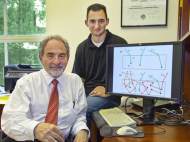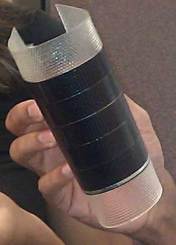Using luminescence to break the solar cell efficiency record
 Researchers from the University of California, Berkeley, came across a relatively simple solution based on a mathematical connection between absorption and emission of light that could lead to improvement of flat-plate solar cell efficiency. Although their concept is counterintuitive, the researchers managed to demonstrate that solar cells which are able to emit light more efficiently are able to absorb it better as well.
Researchers from the University of California, Berkeley, came across a relatively simple solution based on a mathematical connection between absorption and emission of light that could lead to improvement of flat-plate solar cell efficiency. Although their concept is counterintuitive, the researchers managed to demonstrate that solar cells which are able to emit light more efficiently are able to absorb it better as well.
Since 1961, scientists have determined that there is a limit to the amount of electrical energy that can be harvested by flat-plate (“single junction”) solar cells, and the limit they’ve come up with is about 33.7 percent. The most efficient single junction thin film crystal solar cell before these findings was 26% efficient, but the EC Berkeley team led by Eli Yablonovitch, UC Berkeley professor of electrical engineering, believed that their concept could bring us closer to the theoretical limit.
“Fundamentally, it’s because there’s a thermodynamic link between absorption and emission”, said Owen Miller, a graduate student at UC Berkeley and a member of Yablonovitch’s group. “If you have a solar cell that is a good emitter of light, it also makes it produce a higher voltage, which in turn increases the amount of electrical energy that can be harvested from the cell for each unit of sunlight.”
Solar cells produce electricity when photons from the Sun hit the semiconductor material within a cell. The energy from the photons knocks electrons loose from this material, allowing the electrons to flow freely. But the process of knocking electrons free can also generate new photons, in a process called luminescence.
A Bay area-based company called Alta Devices, co-founded by Yablonovitch, pursued to realize their idea to allow these luminescence generated photons to escape from the cell as easily as possible. They designed the cell in a way that allows light to escape as easily as possible from the cell by employing techniques that led to increased reflectivity of the rear mirror, and applied their concept on a prototype solar cell made of gallium arsenide (GaAs), a material often used to make solar cells in satellites.
Since GaAs production tends to be expensive, Alta Devices invented a manufacturing technique that enables extremely thin layers of GaAs that are about one micron thick – 40 times thinner than a human hair and a fraction of the GaAs layer thickness used for earlier solar cells.
The prototype broke the record for single-junction GaAs thin film crystal solar cells, and the latest version of it achieved record efficiency of 28.8 percent. Although the results are counterintuitive because you would expect that the larger number of photons would create more electrons, mathematically, allowing the new photons to escape increases the voltage that the cell is able to produce.
Yablonovitch hopes that this approach will provide them a way to achieve efficiencies close to 30% in the coming years. And since the work applies to all types of solar cells, the findings could increase the efficiency for other types of solar cells.










author
UC Berkeley researchers will present their findings at the Conference on Lasers and Electro Optics (CLEO: 2012), to be held May 6-11 in San Jose, California.